wipers Citroen C3 2017 2.G Owner's Manual
[x] Cancel search | Manufacturer: CITROEN, Model Year: 2017, Model line: C3, Model: Citroen C3 2017 2.GPages: 450, PDF Size: 10.11 MB
Page 4 of 450
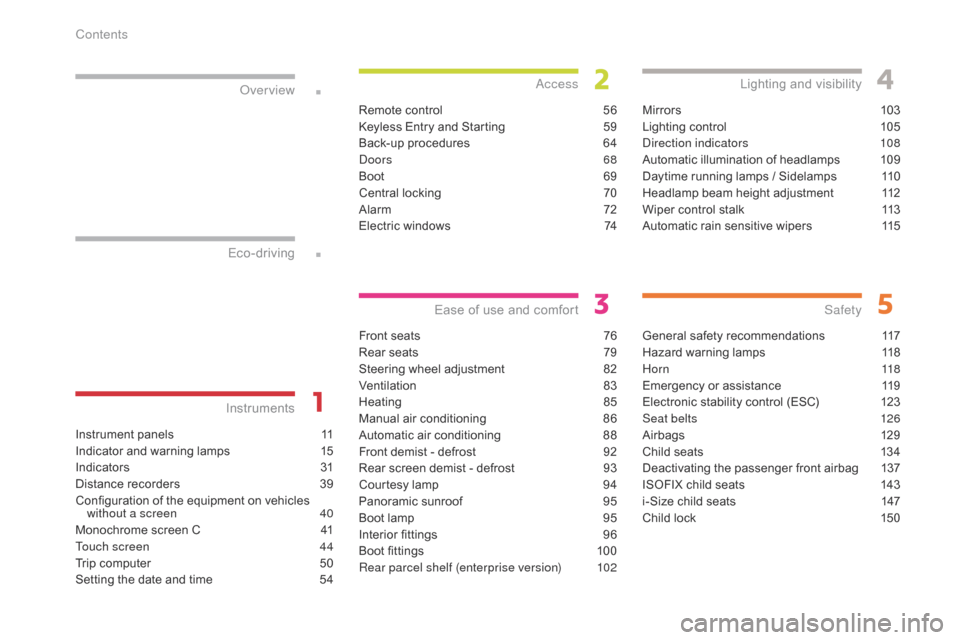
.
.
B618_en_Chap00a_sommaire_ed01-2016
Instrument panels 11
Indicator and warning lamps
1
5
Indic ators
31
D
istance recorders
3
9
Configuration of the equipment on vehicles without a screen
4
0
Monochrome screen C
4
1
Touch screen
4
4
Trip computer
5
0
Setting the date and time
5
4
InstrumentsOver view
Remote control 5
6
Keyless Entry and Starting
5
9
Back-up procedures
6
4
Doors
68
Boot
6
9
Central locking
7
0
Alarm
7
2
Electric windows
7
4
Access
Front seats 76
Rear seats
7
9
Steering wheel adjustment
8
2
Ventilation
8
3
Heating
8
5
Manual air conditioning
8
6
Automatic air conditioning
8
8
Front demist - defrost
9
2
Rear screen demist - defrost
9
3
Courtesy lamp
9
4
Panoramic sunroof
9
5
Boot lamp
9
5
Interior fittings
9
6
Boot fittings
1
00
Rear parcel shelf (enterprise version)
1
02
Ease of use and comfort
Mirrors 10 3
Lighting control
1
05
Direction indicators
1
08
Automatic illumination of headlamps
1
09
Daytime running lamps / Sidelamps
1
10
Headlamp beam height adjustment
1
12
Wiper control stalk
1
13
Automatic rain sensitive wipers
1
15
Lighting and visibility
General safety recommendations 1 17
Hazard warning lamps
1
18
H o r n
11
8
Emergency or assistance
1
19
Electronic stability control (ESC)
1
23
Seat belts
1
26
Airbags
1
29
Child seats
1
34
Deactivating the passenger front airbag
1
37
ISOFIX child seats
1
43
i-Size child seats
1
47
Child lock
1
50
Safety
Eco-driving
Contents
Page 111 of 450
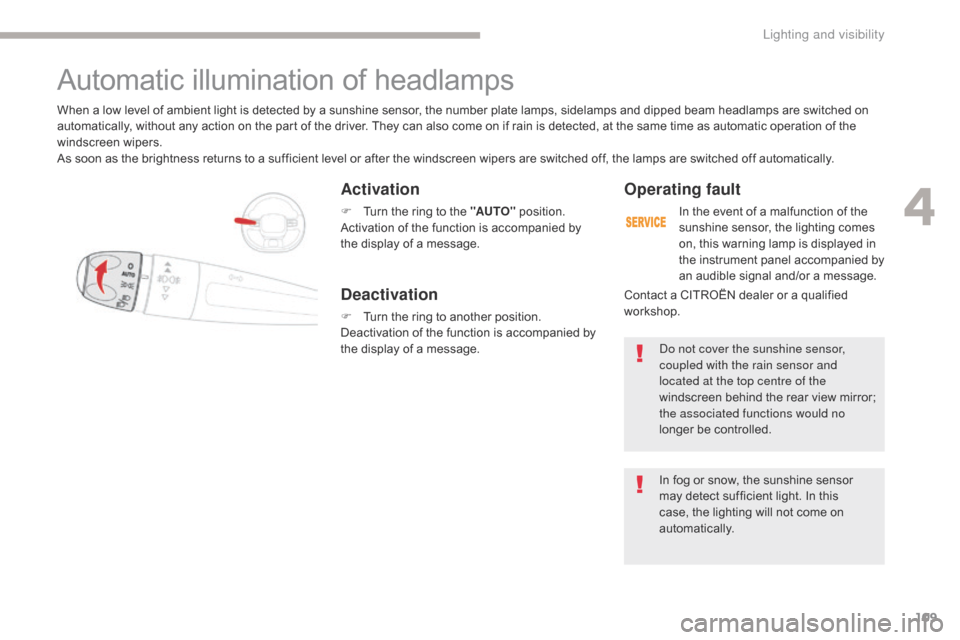
109
B618_en_Chap04_Eclairage-et-visibilite_ed01-2016
Activation
F Turn the ring to the "AUTO" position.
Activation of the function is accompanied by
the display of a message.
When a low level of ambient light is detected by a sunshine sensor, the number plate lamps,
sidelamps and dipped beam headlamps are switched on
automatically, without any action on the part of the driver. They can also come on if rain is detected, at the same time as automatic operation of the
windscreen wipers.
As soon as the brightness returns to a sufficient level or after the windscreen wipers are switched off, the lamps are switched off automatically.
Deactivation
F Turn the ring to another position.
Deactivation of the function is accompanied by
the display of a message.
Operating fault
In the event of a malfunction of the
sunshine sensor, the lighting comes
on, this warning lamp is displayed in
the instrument panel accompanied by
an audible signal and/or a message.
Do not cover the sunshine sensor,
coupled with the rain sensor and
located at the top centre of the
windscreen behind the rear view mirror;
the associated functions would no
longer be controlled.
Contact a CITROËN dealer or a qualified
workshop.
Automatic illumination of headlamps
In fog or snow, the sunshine sensor
may detect sufficient light. In this
case, the lighting will not come on
automatically.
4
Lighting and visibility
Page 115 of 450
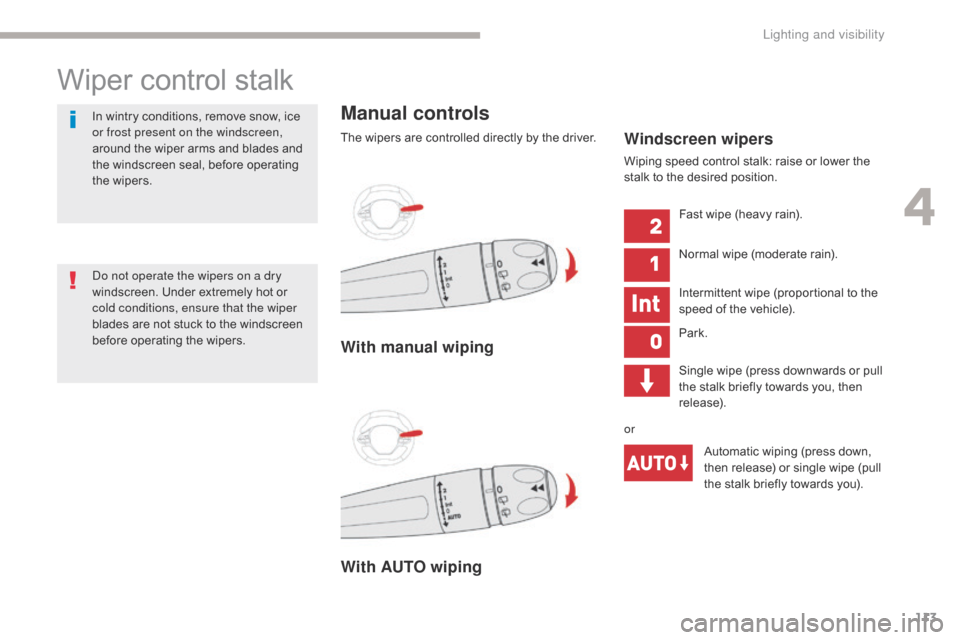
113
B618_en_Chap04_Eclairage-et-visibilite_ed01-2016
Wiper control stalk
Manual controls
The wipers are controlled directly by the driver.
With AUTO wiping With manual wipingWindscreen wipers
Wiping speed control stalk: raise or lower the
stalk to the desired position.
Fast wipe (heavy rain).
Normal wipe (moderate rain).
Intermittent wipe (proportional to the
speed of the vehicle).
Park.
Single wipe (press downwards or pull
the stalk briefly towards you, then
release).
or Automatic wiping (press down,
then release) or single wipe (pull
the stalk briefly towards you).
Do not operate the wipers on a dry
windscreen. Under extremely hot or
cold conditions, ensure that the wiper
blades are not stuck to the windscreen
before operating the wipers. In wintry conditions, remove snow, ice
or frost present on the windscreen,
around the wiper arms and blades and
the windscreen seal, before operating
the wipers.
4
Lighting and visibility
Page 116 of 450

114
B618_en_Chap04_Eclairage-et-visibilite_ed01-2016
Rear wiper
Park.
Intermittent wipe (proportional to the
vehicle speed).
Wash-wipe (set duration).
Rear wiper selection ring:
Reverse gear
When reverse gear is engaged, the rear wiper
will come into operation automatically if the
windscreen wipers are operating.
Activation or deactivation of this automatic
function can only
be set via the touch screen.
Windscreen wash
Pull the wiper stalk towards you. The
windscreen wash, then the windscreen wipers,
operate for a pre-determined time.
The screenwash jets are not adjustable.
Do not try to move them (risk of
damage).
F
I
n the Driving
menu, select the
" Vehicle settings " tab.
F
Sel
ect "
Comfort " then "Rear
wiper in reverse ".
This function is activated by default.
If a significant accumulation of snow or
ice is present, or when using a bicycle
carrier on the boot, deactivate the
automatic rear wiper.
Lighting and visibility
Page 117 of 450

115
B618_en_Chap04_Eclairage-et-visibilite_ed01-2016
Do not cover the rain sensor, linked with
the sunshine sensor and located in the
centre of the windscreen behind the rear
view mirror.
Switch off the automatic rain sensitive
wipers when using an automatic car wash.
In winter, it is advisable to wait until the
windscreen is completely clear of ice
before activating the automatic rain
sensitive wipers.
Operating fault
If a fault occurs with the automatic rain
sensitive wipers, the wipers will operate in
intermittent mode.
Have the system checked by a CITROËN
dealer or a qualified workshop.
The windscreen wipers operate automatically,
without any action on the part of the driver, if
rain is detected (sensor behind the rear view
mirror), adapting their speed to the intensity of
the rainfall.
Switching on Switching off
The automatic rain sensitive windscreen
wipers must be reactivated, by pushing
the control stalk downwards, if the
ignition has been off for more than
one
minute.
Briefly push the control stalk
downwards.
A wiping cycle confirms that the
instruction has been accepted.
This symbol appears in the
instrument panel display and a
message is displayed. Briefly push the control stalk
downwards again, or place the control
stalk in another position (Int, 1 or 2).
Automatic rain sensitive windscreen wipers
This symbol disappears from the instrument
panel display and a message is displayed.
4
Lighting and visibility
Page 118 of 450
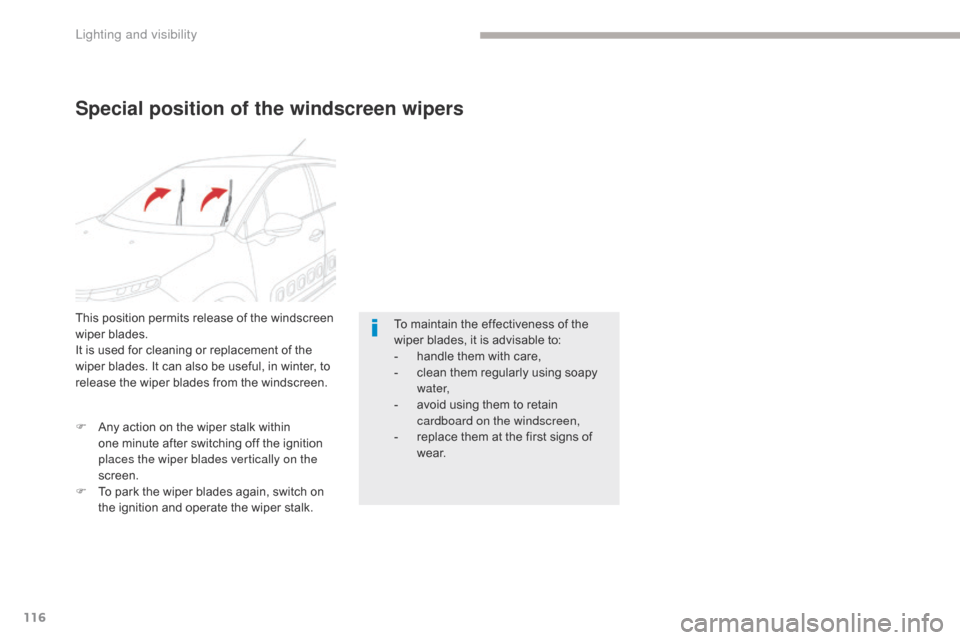
116
B618_en_Chap04_Eclairage-et-visibilite_ed01-2016
Special position of the windscreen wipers
To maintain the effectiveness of the
wiper blades, it is advisable to:
-
h
andle them with care,
-
c
lean them regularly using soapy
water,
-
a
void using them to retain
cardboard on the windscreen,
-
r
eplace them at the first signs of
w e a r.
This position permits release of the windscreen
wiper blades.
It is used for cleaning or replacement of the
wiper blades. It can also be useful, in winter, to
release the wiper blades from the windscreen.
F
A
ny action on the wiper stalk within
one
minute after switching off the ignition
places the wiper blades vertically on the
screen.
F
T
o park the wiper blades again, switch on
the ignition and operate the wiper stalk.
Lighting and visibility
Page 157 of 450
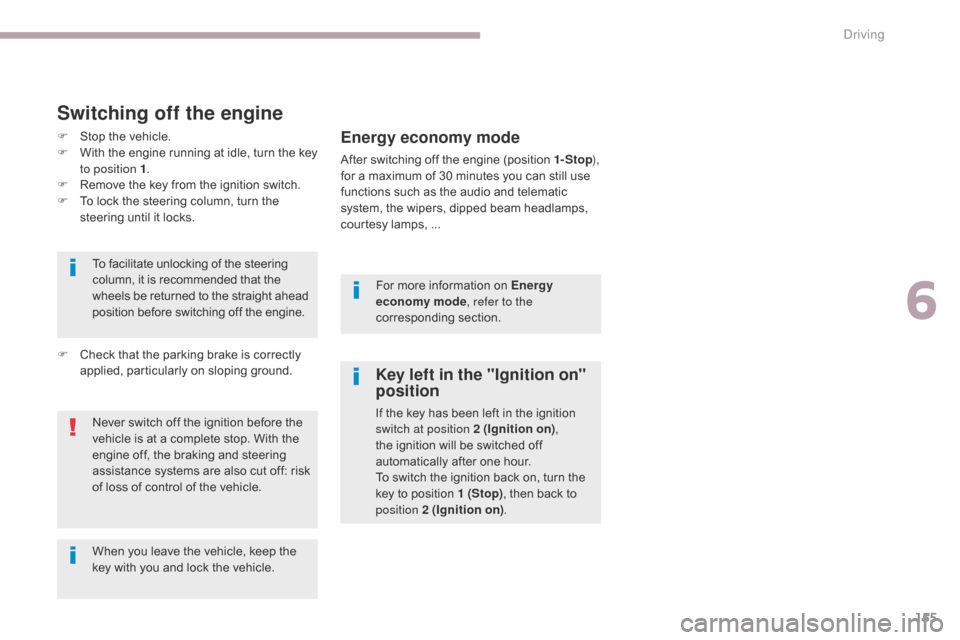
155
B618_en_Chap06_conduite_ed01-2016
Key left in the "Ignition on"
position
If the key has been left in the ignition
switch at position 2 (Ignition on),
the ignition will be switched off
automatically after one hour.
To switch the ignition back on, turn the
key to position 1 (Stop) , then back to
position 2 (Ignition on) .
Never switch off the ignition before the
vehicle is at a complete stop. With the
engine off, the braking and steering
assistance systems are also cut off: risk
of loss of control of the vehicle.
When you leave the vehicle, keep the
key with you and lock the vehicle. To facilitate unlocking of the steering
column, it is recommended that the
wheels be returned to the straight ahead
position before switching off the engine.
Switching off the engine
F Stop the vehicle.
F
W ith the engine running at idle, turn the key
to position 1 .
F
R
emove the key from the ignition switch.
F
T
o lock the steering column, turn the
steering until it locks.
F
C
heck that the parking brake is correctly
applied, particularly on sloping ground. For more information on Energy
economy mode
, refer to the
corresponding section.Energy economy mode
After switching off the engine (position 1- Stop ),
for a maximum of 30 minutes you can still use
functions such as the audio and telematic
system, the wipers, dipped beam headlamps,
courtesy lamps, ...
6
Driving
Page 205 of 450
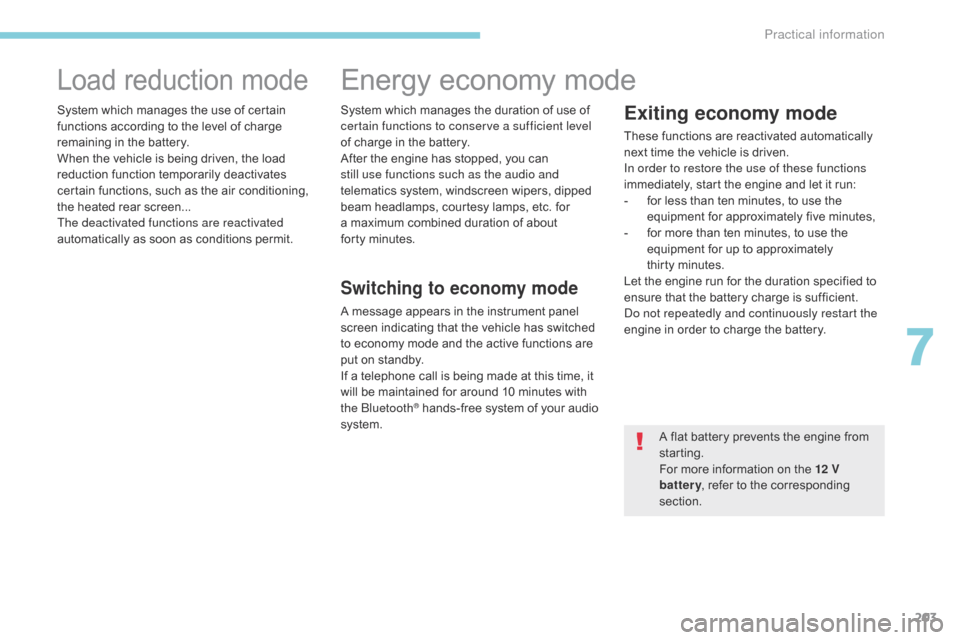
203
B618_en_Chap07_info-pratiques_ed01-2016
Load reduction mode
System which manages the use of certain
functions according to the level of charge
remaining in the battery.
When the vehicle is being driven, the load
reduction function temporarily deactivates
certain functions, such as the air conditioning,
the heated rear screen...
The deactivated functions are reactivated
automatically as soon as conditions permit.System which manages the duration of use of
certain functions to conserve a sufficient level
of charge in the battery.
After the engine has stopped, you can
still use functions such as the audio and
telematics system,
windscreen wipers, dipped
beam headlamps,
courtesy lamps, etc. for
a maximum combined duration of about
forty
m
inutes.
Energy economy mode
Switching to economy mode
A message appears in the instrument panel
screen indicating that the vehicle has switched
to economy mode and the active functions are
put on standby.
If a telephone call is being made at this time, it
will be maintained for around 10 minutes with
the Bluetooth
® hands-free system of your audio
system.
Exiting economy mode
These functions are reactivated automatically
next time the vehicle is driven.
In order to restore the use of these functions
immediately, start the engine and let it run:
-
f
or less than ten minutes, to use the
equipment for approximately five minutes,
-
f
or more than ten minutes, to use the
equipment for up to approximately
thirty
m
inutes.
Let the engine run for the duration specified to
ensure that the battery charge is sufficient.
Do not repeatedly and continuously restart the
engine in order to charge the battery.
A flat battery prevents the engine from
starting.
For more information on the 12 V
battery , refer to the corresponding
section.
7
Practical information
Page 249 of 450

247
B618_en_Chap08_En-cas-de-panne_ed01-2016
FuseN° Rating
(A) Functions
F25 40Towbar pre-equipment.
F26 15Automatic gearbox or LPG system.
F27 25Built-in systems inter face (BSI).
F28 30Diesel emissions control system (AdBlue
®).
F29 40Windscreen wipers.
F3 50Passenger compartment fusebox.
F30 40Diesel pre-heating unit.
F31 80Additional heating (depending on equipment).
F32 80Power steering.
F4 30A B S / E S P.
F5 70Built-in systems inter face (BSI).
F6 60Cooling fan assembly.
F7 80Built-in systems inter face (BSI).
F8 15Engine management.
F9 15Engine management.
8
In the event of a breakdown
Page 251 of 450
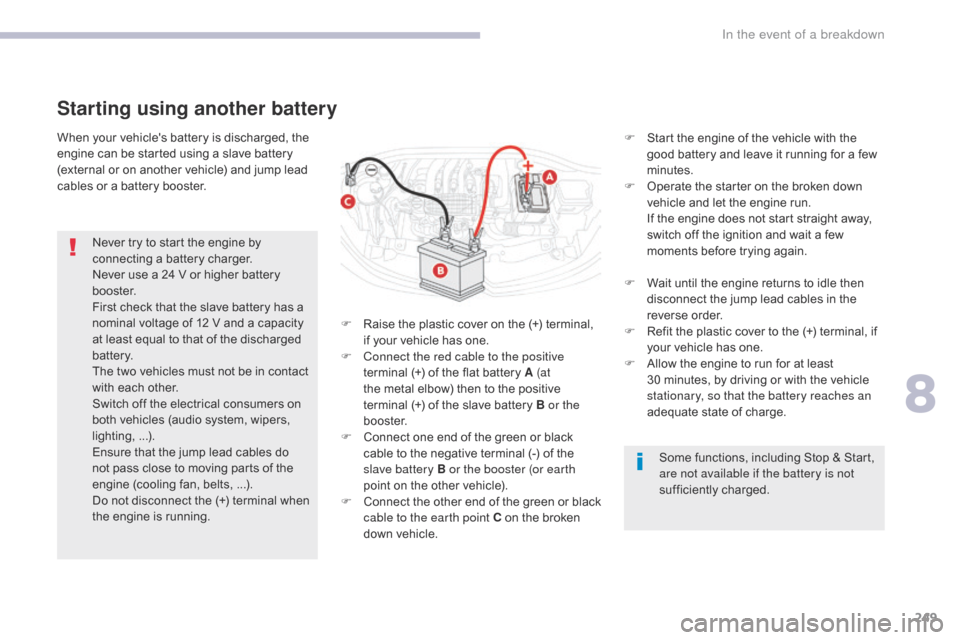
249
B618_en_Chap08_En-cas-de-panne_ed01-2016
When your vehicle's battery is discharged, the
engine can be started using a slave battery
(external or on another vehicle) and jump lead
cables or a battery booster.
Starting using another battery
F Raise the plastic cover on the (+) terminal, if your vehicle has one.
F
C
onnect the red cable to the positive
terminal (+) of the flat battery A (at
the metal elbow) then to the positive
terminal
(+) of the slave battery B or the
b o o s t e r.
F
C
onnect one end of the green or black
cable to the negative terminal (-) of the
slave battery B or the booster (or earth
point on the other vehicle).
F
C
onnect the other end of the green or black
cable to the earth point C on the broken
down vehicle. F
S
tart the engine of the vehicle with the
good battery and leave it running for a few
minutes.
F
O
perate the starter on the broken down
vehicle and let the engine run.
I
f the engine does not start straight away,
switch off the ignition and wait a few
moments before trying again.
Never try to start the engine by
connecting a battery charger.
Never use a 24 V or higher battery
b o o s t e r.
First check that the slave battery has a
nominal voltage of 12 V and a capacity
at least equal to that of the discharged
battery.
The two vehicles must not be in contact
with each other.
Switch off the electrical consumers on
both vehicles (audio system, wipers,
lighting,
...
).
Ensure that the jump lead cables do
not pass close to moving parts of the
engine (cooling fan, belts,
...).
Do not disconnect the (+) terminal when
the engine is running. F
W
ait until the engine returns to idle then
disconnect the jump lead cables in the
reverse order.
F R efit the plastic cover to the (+) terminal, if
your vehicle has one.
F
A
llow the engine to run for at least
30
minutes, by driving or with the vehicle
stationary, so that the battery reaches an
adequate state of charge.
Some functions, including Stop & Start,
are not available if the battery is not
sufficiently charged.
8
In the event of a breakdown